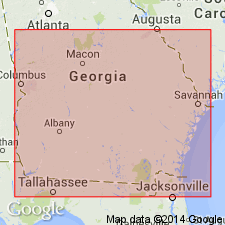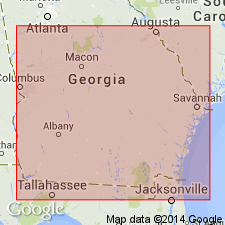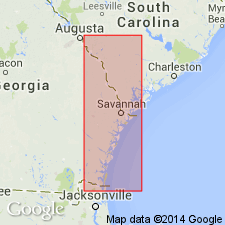
- Usage in publication:
-
- Satilla formation
- Modifications:
-
- Named
- Dominant lithology:
-
- Clay
- Sand
- Gravel
- AAPG geologic province:
-
- South GA-North FL sedimentary province
Summary:
Named Satilla formation for development along both sides of Satilla River, in Camden and Charlton Cos., GA. Unit is considered the latest Pleistocene deposits in GA, consisting of coastal-terrace deposits and fluviatile or river-terrace deposits. The coastal deposits lie upon a wave-cut terrace which extends 20 to 30 miles back from present ocean at elevations of 15 to 40 feet above sea level. The western limit of this terrace or plain is marked by the high sand ridge east of Folkston, Charlton Co., and by the escarpment at Waynesville and Mount Pleasant, Wayne Co., and at Walthoursville, Liberty Co. Is first marine terrace. The deposits on Satilla plain rest unconformably on Pliocene or Miocene strata. They consist of greenish and bluish marine clays, gray, white, and yellow sands, and thin layers of gravel, all unconsolidated. Thickness is 15-50 feet. The relative age of the formation with respect to older Okefenokee formation is determined by its topographic position and not by stratigraphic sequence or paleontologic evidence. The Satilla formation is fossiliferous; the topographically higher Okefenokee formation is not. Unit is included in Columbia group.
Source: GNU records (USGS DDS-6; Reston GNULEX).

- Usage in publication:
-
- Satilla Formation
- Modifications:
-
- Reinstated
- AAPG geologic province:
-
- Atlantic Coast basin
- South GA-North FL sedimentary province
Summary:
Satilla Formation of Veatch and Stephenson (1911) is here reintroduced as a lithostratigraphic unit of formation rank. Though originally defined as Pleistocene coastal marine and river terrace deposits, the unit is here restricted to just coastal marine deposits, but expanded to include those of both Pleistocene and Holocene age. As defined here, the Satilla includes the Pamlico Formation of Cooke (1943), the Princess Anne and Silver Bluff Formations (Hails and Hoyt, 1969), and the Holocene shoreline complexes of Mann (1976). Lithologically heterogeneous, consisting for the most part of fine- to medium-grained and well sorted sand, variably bedded and variably calcareous and fossiliferous, silty to sandy clay, and massive-bedded, blocky to hackly clay. Unit is restricted to the lower marine terrace region in eastern GA and extends northward into SC, and southward into FL. Generally, disconformably overlies the Coosawhatchie Formation. Locally overlies the Raysor, Cypresshead (new name), or Nashua Formations. Occurs at the top of the geologic section and underlies only surficial sand and alluvial deposits. Thickness distribution has not been established. Approximately 10 ft (3 m) exposed at type locality; ranges to 88 ft (27 m). Age is late Pleistocene and Holocene based on molluscan fauna. There is no indication that any part of unit is as old as early or middle Pleistocene.
Source: GNU records (USGS DDS-6; Reston GNULEX).

- Usage in publication:
-
- Satilla Formation
- Modifications:
-
- Biostratigraphic dating
- AAPG geologic province:
-
- Atlantic Coast basin
Summary:
Authors do not follow usage of Huddlestun (1988) for Satilla Formation, who restricted Satilla to coastal marine sediments. It is noted in this report that recent field work by Markewich suggests an alternative to Huddlestun's concept that would more closely agree with stratigraphy of McCartan and others (1984, 1990) in Charleston area, SC. Pleistocene sediments near the coast in southeastern GA contain sparse invertebrate fossils, but vertebrate fossils include giant ground sloth MEGATHERIUM, box tortoise TERRAPENE CANALICULATA, mastodon MAMMUT AMERICANUM, and sloth MYLODON HARLANI, as well as giant beaver, elephant, buffalo, deer, tapir, horse, crocodile, and fish (Hay, 1923). Differences in vertebrate and invertebrate faunal and (or) floral assemblages aren't sufficient to differentiate Pleistocene units. Authors suggest that deposits associated with surfaces between 20 and 30 ft altitude are younger than 200 ka, based on work by McCartan and others (1982, 1984, 1990) and Owens (1989).
Source: GNU records (USGS DDS-6; Reston GNULEX).
For more information, please contact Nancy Stamm, Geologic Names Committee Secretary.
Asterisk (*) indicates published by U.S. Geological Survey authors.
"No current usage" (†) implies that a name has been abandoned or has fallen into disuse. Former usage and, if known, replacement name given in parentheses ( ).
Slash (/) indicates name conflicts with nomenclatural guidelines (CSN, 1933; ACSN, 1961, 1970; NACSN, 1983, 2005, 2021). May be explained within brackets ([ ]).

